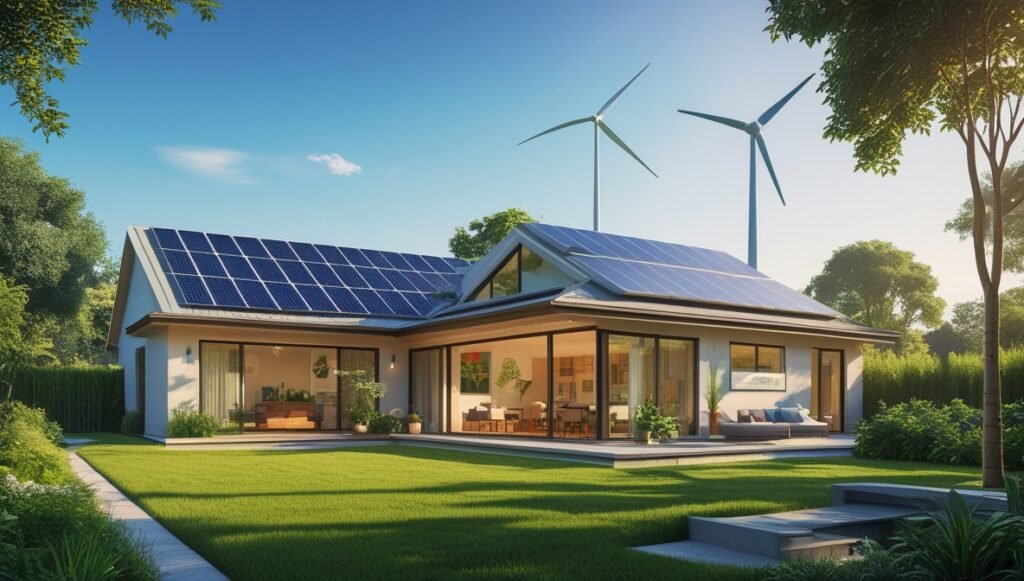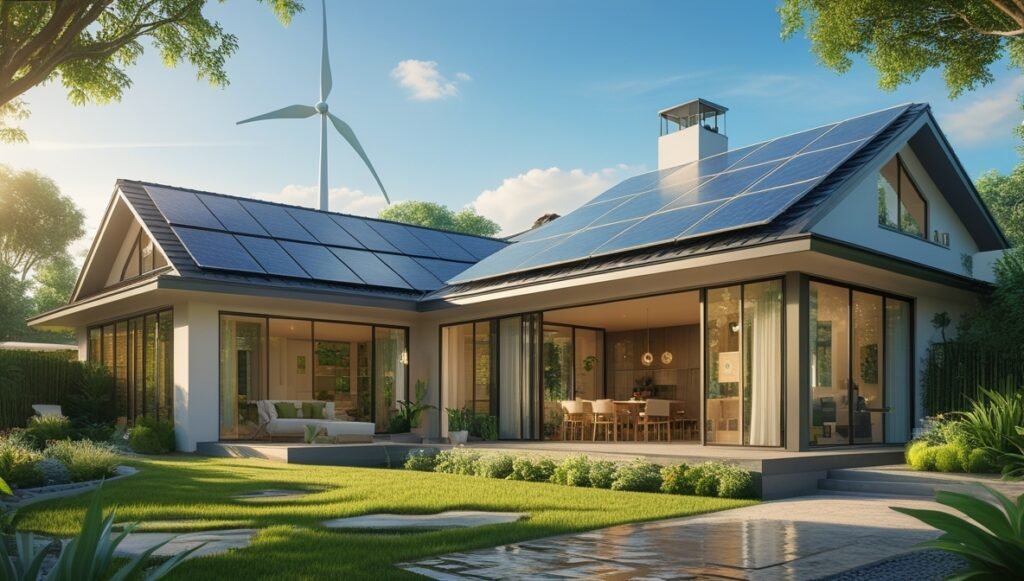
Introduction
In an era marked by environmental challenges and rapid technological advancements, the pursuit of sustainable living has become a top priority for homeowners and communities alike. Integrating eco-friendly practices into our living spaces is not only beneficial for the planet but also for long-term economic savings and personal well-being. At the heart of sustainable living lies renewable energy—an essential component that transforms traditional homes into green, efficient sanctuaries. This article delves into the principles of green home practices and the transformative role of renewable energy. It explores practical strategies, economic benefits, environmental impacts, and future trends that are redefining modern living. As an SEO expert with a formal approach, this comprehensive discussion is designed to inform and empower readers to create a sustainable living environment that stands the test of time.
Understanding Green Home Practices
Green home practices refer to a range of strategies and solutions designed to reduce a home’s environmental impact. These practices encompass energy conservation, water efficiency, waste reduction, sustainable building materials, and overall smart design. The objective is to create a home that not only minimizes resource consumption but also promotes a healthier lifestyle.
Key Components of a Green Home
- Energy Efficiency:
Energy efficiency involves optimizing a home’s systems—such as lighting, heating, and cooling—to consume less energy while delivering the same level of performance. High-efficiency appliances, LED lighting, and smart thermostats are common examples. - Water Conservation:
Reducing water consumption through low-flow fixtures, rainwater harvesting systems, and water-efficient landscaping helps conserve a vital resource while lowering utility bills. - Sustainable Materials:
The use of eco-friendly building materials, such as recycled steel, bamboo, reclaimed wood, and low-VOC (volatile organic compounds) paints, is crucial. These materials not only reduce the environmental footprint but also improve indoor air quality. - Waste Reduction:
Implementing recycling and composting practices, along with designing spaces for minimal waste, contributes significantly to a sustainable lifestyle. Effective waste management reduces landfill use and promotes a circular economy. - Indoor Environmental Quality:
A healthy home environment is essential for overall well-being. This involves using non-toxic materials, ensuring proper ventilation, and maintaining optimal humidity levels to reduce allergens and pollutants.
- Programmable smart thermostat that learns your schedule and the temperatures you like and programs itself to help you sa…
- Home/Away Assist automatically adjusts itself to an Eco Temperature after you leave, so you don’t heat or cool an empty …
- With Energy History, just check your phone to see how much energy you used and why, or use Quick View on the display to …
The Role of Renewable Energy in Green Homes
Renewable energy is a cornerstone of green home practices. It involves harnessing natural resources—such as sunlight, wind, and geothermal heat—to generate power with minimal environmental impact. Unlike fossil fuels, renewable energy sources are inexhaustible and produce little to no greenhouse gas emissions.
Types of Renewable Energy for Homes
- Solar Energy:
Solar panels convert sunlight into electricity. They can be installed on rooftops or in ground-mounted arrays and are among the most popular renewable energy sources for residential applications. Advances in photovoltaic technology have increased efficiency and reduced installation costs, making solar energy a viable option for many homeowners. - Wind Energy:
Small-scale wind turbines can generate power for homes, particularly in areas with consistent wind patterns. While less common than solar panels, wind energy is an effective supplement in regions where wind is abundant. - Geothermal Energy:
Geothermal systems utilize the constant temperature of the earth to heat and cool homes. By circulating a fluid through underground pipes, these systems can extract or dissipate heat, offering an energy-efficient alternative to traditional HVAC systems. - Biomass Energy:
Biomass involves using organic materials, such as wood pellets or agricultural waste, to produce energy. Although more common in larger or rural settings, biomass can be a renewable energy option for certain residential applications.
Advantages of Renewable Energy Integration
- Reduced Energy Bills:
Once installed, renewable energy systems can significantly lower electricity costs by reducing reliance on the grid. In many cases, excess energy generated can be sold back to the utility company, further enhancing savings. - Environmental Benefits:
Renewable energy systems produce little to no carbon emissions, contributing to a reduction in air pollution and helping mitigate climate change. By adopting renewable energy, homeowners play an active role in preserving the environment. - Energy Independence:
Utilizing renewable energy provides a measure of independence from fluctuating energy prices and supply issues associated with fossil fuels. Homeowners can enjoy a more stable and predictable energy source. - Increased Home Value:
Energy-efficient homes equipped with renewable energy systems are increasingly sought after in the real estate market. Such investments can enhance property value and appeal to eco-conscious buyers.
- Compact and Reliable – The 100W 12V Monocrystalline solar panel delivers a stable output of an average 500Wh of electric…
- Superior Quality and Material – All Renogy solar panels are made from 100% EL-tested Grade A+ solar cells to provide the…
- Advanced Solar Cell Tech and Panel Structure – Renogy solar panels adapted the newest 9 Bus-bars cell tech and Half-cell…
Implementing Renewable Energy in the Home
Transitioning to renewable energy can seem daunting; however, practical strategies and modern technologies have made it increasingly accessible. Below are key steps to incorporate renewable energy into your green home practices:
1. Assessing Your Energy Needs
Before investing in renewable energy systems, it is essential to conduct an energy audit. This process involves evaluating your current energy consumption patterns, identifying inefficiencies, and determining the capacity required for a renewable system. An energy audit can be performed by professionals or using online tools that provide insights into your energy usage.
2. Evaluating Solar Potential
For many homeowners, solar energy is the most feasible renewable option. Assess the solar potential of your property by considering factors such as roof orientation, shading, and local climate. Many solar companies offer free consultations and site evaluations to determine the viability of installing solar panels.
3. Choosing the Right Technology
There are various renewable energy technologies available, each with its unique benefits and considerations. Homeowners should research the options that best align with their needs:
- Photovoltaic Panels: Best suited for converting sunlight directly into electricity.
- Solar Water Heaters: Use solar energy to heat water, reducing reliance on traditional water heating methods.
- Wind Turbines: Ideal for areas with consistent wind but may require additional space and permits.
- Geothermal Systems: Highly efficient for heating and cooling but involve higher initial installation costs.
4. Financial Incentives and Tax Credits
Many governments offer incentives to encourage the adoption of renewable energy. These may include tax credits, rebates, and low-interest financing options that can significantly offset installation costs. Research local, state, and federal programs to maximize financial benefits.
5. Integrating with Existing Systems
Renewable energy systems can often be integrated with existing home infrastructure. For instance, solar panels can be combined with battery storage systems to provide backup power during outages. Smart home technology can further optimize energy usage by automating the operation of renewable systems and monitoring overall energy efficiency.
6. Maintenance and Long-Term Considerations
Renewable energy systems require minimal maintenance compared to conventional systems; however, routine inspections and occasional servicing are necessary to ensure optimal performance. Consider the long-term durability of the technology, warranties offered by manufacturers, and the availability of local support services.
Economic and Environmental Impact
Investing in green home practices and renewable energy offers significant economic and environmental benefits. By reducing reliance on fossil fuels and improving energy efficiency, homeowners can achieve substantial long-term savings while contributing to environmental conservation.
Economic Benefits
- Lower Utility Bills:
Renewable energy systems can dramatically reduce monthly energy expenses, providing long-term financial relief. - Return on Investment:
Although initial costs may be high, renewable energy installations often pay for themselves within a few years through energy savings and government incentives. - Property Value Increase:
Eco-friendly homes are highly attractive in the real estate market, and renewable energy systems can enhance property value and marketability. - Job Creation:
The renewable energy sector contributes to local economies by creating jobs in installation, maintenance, and manufacturing.
Environmental Benefits
- Carbon Footprint Reduction:
Renewable energy systems produce little to no carbon emissions, significantly reducing a home’s overall environmental impact. - Resource Conservation:
Utilizing renewable resources helps conserve finite fossil fuels, ensuring a more sustainable energy supply for future generations. - Pollution Mitigation:
By reducing emissions and waste, green home practices help improve air and water quality, contributing to healthier communities. - Biodiversity Protection:
Sustainable energy practices help protect natural habitats and ecosystems by minimizing the need for environmentally harmful extraction and production processes.

Overcoming Challenges in Renewable Energy Adoption
While the advantages of renewable energy and green home practices are clear, several challenges can hinder widespread adoption. Addressing these challenges requires strategic planning, policy support, and ongoing technological innovation.
1. Initial Cost and Investment
The upfront cost of installing renewable energy systems can be a significant barrier for many homeowners. Despite long-term savings, the initial investment in solar panels, wind turbines, or geothermal systems may be prohibitive. To overcome this challenge, government incentives, low-interest loans, and community-based funding models are essential. These financial tools help bridge the gap between initial costs and long-term benefits.
2. Regulatory and Permitting Issues
Renewable energy installations often require navigating complex regulatory frameworks and obtaining various permits. These processes can be time-consuming and may vary significantly by region. Homeowners must work closely with local authorities and energy providers to ensure compliance with all regulations. Streamlined permitting processes and supportive policies can help facilitate smoother adoption of renewable energy technologies.
3. Technological Integration
Integrating renewable energy systems with existing home infrastructure can present technical challenges. Compatibility with legacy systems, grid connection issues, and the need for advanced monitoring and control systems are common concerns. Advances in smart home technology and grid modernization initiatives are addressing these challenges, making integration increasingly seamless and efficient.
4. Public Awareness and Education
A key factor in the adoption of renewable energy is public awareness. Many consumers may not fully understand the benefits, costs, and operational aspects of renewable energy systems. Educational campaigns, workshops, and accessible online resources can play a vital role in demystifying renewable energy and encouraging more homeowners to make the transition to greener practices.
- WHAT’S IN THE BOX – Includes one Hue Bridge and two Hue white and color ambiance LED smart 60W A19 E26 base light bulbs …
- UNLOCK THE FULL POWER OF HUE WITH INCLUDED BRIDGE – Enjoy automations, control from anywhere in the world, and a secure,…
- MILLIONS OF COLORS – The White & Color Ambiance range offers both warm-to-cool white and millions of colors straight out…
Future Trends in Green Home Practices and Renewable Energy
The landscape of renewable energy and sustainable home practices is continuously evolving. Several emerging trends are set to further transform how we design, build, and live in our homes.
1. Smart Home Integration
The integration of renewable energy systems with smart home technologies is poised to revolutionize energy management. Future homes will feature automated systems that optimize energy usage, monitor system performance in real time, and adjust operations based on occupancy and weather conditions. These smart integrations will enhance energy efficiency, reduce costs, and improve overall home comfort.
2. Energy Storage Advancements
As renewable energy generation increases, the need for effective energy storage solutions becomes paramount. Advances in battery technology—such as lithium-ion and solid-state batteries—are making it possible to store excess energy for later use. These storage solutions enable homes to maintain a steady energy supply even during periods of low renewable generation, further enhancing energy independence and reliability.
3. Distributed Energy Systems
The concept of distributed energy systems, where homes generate, store, and manage their own energy, is gaining traction. These systems, often integrated with microgrids, allow communities to share renewable energy resources, improve grid resilience, and reduce transmission losses. Distributed energy models represent a significant shift away from centralized power generation, empowering consumers to take control of their energy future.
4. Green Building Certification and Standards
As sustainability becomes increasingly important, green building certifications—such as LEED (Leadership in Energy and Environmental Design) and ENERGY STAR—are playing a more significant role in the construction and renovation of homes. These standards provide guidelines and benchmarks for energy efficiency, water conservation, and overall environmental impact, encouraging builders and homeowners to adopt best practices in sustainable design.
5. Innovative Financing Models
To overcome the challenge of high initial costs, innovative financing models are emerging. These include power purchase agreements (PPAs), community solar programs, and green mortgages that offer favorable rates for energy-efficient homes. Such models make renewable energy more accessible to a broader range of consumers, accelerating the transition to sustainable living.
Conclusion
Green home practices and renewable energy are at the forefront of the sustainable living movement. By integrating energy efficiency measures, sustainable materials, and advanced renewable energy systems, homeowners can reduce their environmental impact, lower energy costs, and enjoy a healthier living environment. The adoption of renewable energy—especially when combined with smart home technologies and efficient design—represents a transformative shift toward a more resilient and eco-friendly future.
As we face the dual challenges of climate change and resource depletion, the importance of transitioning to sustainable home practices cannot be overstated. Embracing renewable energy not only ensures energy independence and economic savings but also contributes to global efforts in reducing carbon emissions and protecting natural resources. The future of housing lies in a holistic approach that blends modern technology with time-tested eco-friendly practices, paving the way for communities that are both vibrant and sustainable.
By staying informed about the latest trends, leveraging government incentives, and integrating advanced technologies, homeowners can lead the charge in creating a greener, more efficient, and healthier living environment. The journey toward sustainable living is a collective effort—one that requires informed decision-making, responsible practices, and a commitment to the well-being of both our homes and our planet.

Sarah Thompson is a passionate advocate for healthy living and mindful lifestyle choices. With a background in nutrition science and years of experience as a wellness coach, Sarah dedicates her time to exploring the latest trends, research, and products that promote physical, mental, and emotional well-being.
As the lead writer for The Review Health , Sarah combines her expertise with a genuine love for helping others make informed decisions about their health. Her articles are designed to inspire and educate, offering practical tips, honest reviews, and science-backed insights to support readers on their journey to a healthier, happier life.
When she’s not writing or researching, Sarah enjoys yoga, experimenting with plant-based recipes, and spending time outdoors with her family.





